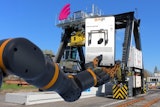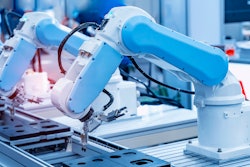The influence of Big Data in manufacturing has the potential to revolutionize how we build, produce and live. It also presents fresh challenges to the manufacturing industry. Chief among them is the exponential growth in volume, velocity and complexity of data coursing throughout the entire manufacturing enterprise. With ever-greater amounts of machine-to-machine, person-to-machine and person-to-person data being captured and analyzed, manufacturers have the opportunity to lower costs, increase profit and gather valuable insights. Here’s how:
The Evolution of Data in Manufacturing: “Just in Time” to “Data in Motion”
For decades, manufacturers have invested in and developed technologies that leverage “just in time” and “Six Sigma” methodologies to drive flexibility and scalability into their production and supply chain operations, achieve zero defect quality performance, and efficiently meet the growing demand and expectations of a connected and intelligent consumer market—all while reducing cost and increasing product margins.
Over the last 20 years, data analytics has moved front and center as the means to drive value across the entire manufacturing value chain. At the enterprise level, it has accounted for the lion’s share of development and investment — resulting in an alphabet soup of business software systems, from ERP (Enterprise Resource Planning) and MRP (Material Resource Planning), to SCM (Supply Chain Management), PLM (Product Lifecycle Management) and CRM (Customer Relationship Management).
To take advantage of these systems, manufacturers developed processes around a paradigm of collect, forward, store, analyze and report data. It’s an approach that presents challenges, and opportunities, to the industry: Is the right data being collected from the right sources? Is the data delivered at the right time and to the right person or organization? Is the data accessible and delivered in efficient formats that lead to good decisions?
Fast-forward to the present and another paradigm shift: “Big Data.” As the Internet of Things gathers momentum, this challenge intensifies as the amount of available data grows. This data deluge will only grow as the next phase of the Internet of Things — the Internet of Everything — comes online. According to the Cisco Visual Networking Index, by 2017, there will be 1.7 billion machine-to-machine wireless connections—including asset-tracking systems in shipping and manufacturing sectors.
Just as a person reading a book must understand the definitions of the words on the page, the value of Big Data must be realized for long-lasting impact. For today’s manufacturers, the essential challenge becomes: How to effectively harness and leverage the vast amounts of data collected from various sources to drive sound business and operational decisions throughout the entire manufacturing value chain? There are obstacles to meeting this challenge. Currently, many of the business and supply chain management systems are “siloed” within the manufacturing enterprise. In addition, out of the vast amount of data generated, a significant portion falls “on the floor” and goes unused. For many manufacturers, the consensus is that much of the data collected doesn’t have sufficient value because it is not delivered in real-time to the correct decision makers in a format that is easily digestible.
Manufacturers are looking for a methodology to “stitch” these various business systems into a cohesive and integrated decision engine that will combine, for example, data from computer-aided design, computer-aided manufacturing, collaborative product development management, and digital manufacturing production systems across organizational boundaries. This will help drive innovation, quality and cost savings throughout the organization. That is to say, Big Data is not enough. Manufacturers also need to collect, analyze and report the data dynamically. They need to harness “Data in Motion.”
The Impacts of Data in Motion in Manufacturing
Data in Motion is a term used to describe the continuous interactions between connected elements such as people, processes and things. Put another way, more and more data types from new devices, sensors and cameras are at maximum value while still in motion. During these interactions, the intelligent network provides contextual information—such as location, identity and presence — at a high velocity. By analyzing this data, value can be extracted and control exerted through security, policy changes or local processing. Data in Motion is information that has previously been largely untapped — a giant superset of the persistent data that is the subject of Big Data today.
This is of special interest in the manufacturing environment, which presents a wide variety of requirements for the timely processing of data. Process interface requires response times that are measured in milliseconds. Manufacturing equipment deals with seconds, while manufacturing enterprise systems and supply chain applications process data in minutes, hours or days. As we get closer to the product being manufactured, volume and variety of data usually increase with velocity. In order to provide a platform for smart factories, the manufacturing infrastructure needs to be able to adapt to these extremely time-sensitive imperatives.
One area where Data in Motion can make a significant difference — specifically, by offering better visibility — is process monitoring and control. Process control systems have been described as hours of sheer boredom interrupted by moments of panic. This potentially dangerous state of affairs could be ameliorated by the use of video analysis to track the movement of machines, products and people, and to alert the appropriate technicians based on the type and severity of any detected exception. Using presence information (available/busy), the solution could “know” where critical personnel are in real time, thus helping to resolve an issue before it becomes critical. It could also bring together different video streams based on real-time video analysis in order to add situational awareness and allow experts to collaborate more effectively. All this requires acting on the insights available through Data in Motion.
Another scenario where Data in Motion could make a huge difference involves sensors on the factory floor. Most manufacturers leverage data from sensors and other intelligent devices in factories, but they tend to limit the power of this data by confining it to islands of automation. To fully capture the value of these devices and propagate the actionable intelligence, data needs to move freely around the manufacturing shop floor and across the supply chain. Take pressure sensors, which have been widely deployed across plant floors to monitor systems and ensure they are applying pre-defined parameters. If controlled by higher-level manufacturing execution systems, this same sensor data could be used in deciding whether to change the pressure envelope based on customer requirements or quality inspections across the entire factory, or even across sites. Again, true business benefits accrue when Data in Motion flows freely across silos.
And let’s not forget the impact of cellular and wireless connectivity, which is accelerating the connection of industrial applications by simplifying access to equipment. Internet of Things technology in general, and machine-to-machine communications in particular are accelerating the sensor-to-ERP connectivity and transforming the way Data in Motion is used to monitor and control manufacturing processes. And it’s not just about accessing data that was out of reach before. It’s also about allowing sensors and people to interact in many different new ways to build new systems and provide more flexibility to manufacturers.
What Does Data in Motion Mean for the Manufacturing Industry?
To truly tap the potential of Data in Motion, manufacturers would do well to weigh a few broad considerations. For one, policies applied to Data in Motion should be sensitive to the priority of the data. After all, not all data are created equal. Take IP-based video surveillance. Video streams of manufacturing equipment humming along without any glitches would be of relatively low priority and might not need to be stored at all, whereas each video frame from cameras at a food processing plant might have to be recorded for regulatory purposes. Video streams identifying the occurrence of an exception would have a higher priority on the network, while alarms or control command to mission critical equipment (or safety equipment) would have priority over all other data—much as an ambulance gets right of way during heavy traffic.
I’ve already talked a little above about how operational efficiencies are achieved when data moves freely around the enterprise. But it’s also important to consider that Data in Motion goes beyond the boundaries of the enterprise. For example, outsourcing across the manufacturing industry has shifted the management of excess capacity to suppliers. As a result, any disruptions in the supply chain immediately affect manufacturing operations and the ability to deliver on time. Therefore, it is critical for suppliers to use both their own internal data (production, shipping) and data from their own suppliers to better predict potential delays.
Data in Motion also takes collaboration to a whole new level. In the smart factory of the future, people play the key role in the success of manufacturing design, operations and support. When management, operators and engineers are able to work together based on quick feedback in a data-driven environment, the benefits abound — from cost containment to production improvement to revenue growth. Extending the same level of collaboration to suppliers and customers is the path to true business transformation. This is not the siloed manufacturing industry of the past. Instead, products being manufactured will be able to talk to the assembly line to communicate quality assurance data and later on call home for service issues. And support teams will be able to access data from different sources and sensors and proactively implement corrective actions while updating the customers on the situation.
And what good is any of the above without adequately securing Data in Motion? Putting anything on the Internet ultimately has risks as well as value. The industrial network has come under attack from malware such as Stuxnet, Duqu and Flame, potentially exposing production equipment. Companies think SCADA networks are not susceptible to eavesdropping, hacking or virus propagation. But access to the Programmable Logic Controllers (PLCs) used throughout the industrial network is possible from indeterminate remote locations. Hackers can get access to PLC and are able to obtain full control, delete files, dump memory and execute commands, retrieve sensitive information, capture passwords, report false data back to the operator, lock the operator out of the PLC, and completely disable the PLC at will. Data therefore needs to be protected in real time and intrusions need to be detected as rapidly as possible in order to avoid irreparable damage. To this end, real-time sense and response and automation are key tenets in tapping the value of Data in Motion and the Internet of Everything.
What’s Next?
The potential of smart factories to drive value across the entire manufacturing value chain is unprecedented. Smart factories can impact business objectives through cost cutting, revenue growth and better workforce collaboration. With this in mind, manufacturing leaders should accelerate adoption of Internet of Everything technologies and consider initiatives that focus on improved collaboration among workers to make employees more efficient.
One specific area where manufacturers can focus to begin reaping these benefits is product line changes, which today can be costly and difficult due to inflexibility. A decade from now when the Internet of Everything is in full swing, however, manufacturers will see increased revenues as a result of being able to produce multiple products with variations in inputs, thus allowing for greater customization of products and smaller product-line runs.
Forward-looking firms have already found that improvements in data collection and analysis are key to greater agility agile and the ability to react quickly to fluctuations in market demand or supply. Those that learn to tap the value of Data in Motion will find themselves well positioned to meet the challenges — and reap the benefits — of the Internet of Everything.























